
Henri Cartier-Bresson was a French artist and humanist photographer considered a master of candid photography, and an early user of 35mm film. He pioneered the genre of street photography, and viewed photography as capturing a decisive moment.
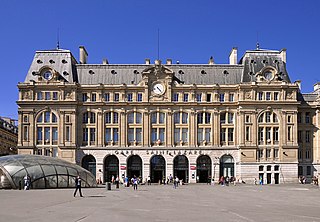
The Gare Saint-Lazare, officially Paris Saint Lazare, is one of the seven large mainline railway station terminals in Paris, France. It was the first train station built in Paris, opening in 1837. It mostly serves train services to western suburbs, as well as intercity services toward Normandy using the Paris–Le Havre railway. Saint-Lazare is the third busiest station in France, after the Gare du Nord and Gare de Lyon. It handles 290,000 passengers each day. The current station building opened in 1889 and was designed by architect Juste Lisch; the maître d'œuvre was Eugène Flachat.
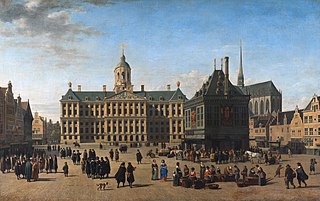
In the visual arts, a cityscape is an artistic representation, such as a painting, drawing, print or photograph, of the physical aspects of a city or urban area. It is the urban equivalent of a landscape. Townscape is roughly synonymous with cityscape, though it implies the same difference in urban size and density implicit in the difference between the words city and town. In urban design the terms refer to the configuration of built forms and interstitial space.
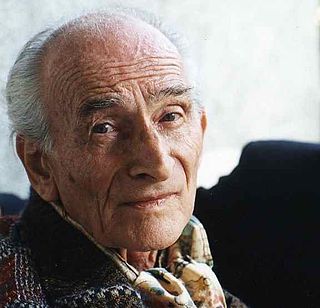
Balthasar Klossowskide Rola, known as Balthus, was a Polish-French modern artist. He is known for his erotically charged images of pubescent girls, but also for the refined, dreamlike quality of his imagery.
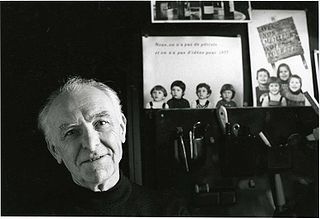
Robert Doisneau was a French photographer. From the 1930s, he photographed the streets of Paris. He was a champion of humanist photography and, with Henri Cartier-Bresson, a pioneer of photojournalism.

Avigdor Arikha was a Romanian-born French–Israeli artist, printmaker and art historian.

Martine Franck was a British-Belgian documentary and portrait photographer. She was a member of Magnum Photos for over 32 years. Franck was the second wife of Henri Cartier-Bresson and co-founder and president of the Henri Cartier-Bresson Foundation.
Raghubir Singh (1942–1999) was an Indian photographer, most known for his landscapes and documentary-style photographs of the people of India. He was a self-taught photographer who worked in India and lived in Paris, London and New York. During his career he worked with National Geographic Magazine, The New York Times, The New Yorker and Time. In the early 1970s, he was one of the first photographers to reinvent the use of color at a time when color photography was still a marginal art form.

Saul Leiter was an American photographer and painter whose early work in the 1940s and 1950s was an important contribution to what came to be recognized as the New York school of photography.
Fazal Sheikh is an artist who uses photographs to document people living in displaced and marginalized communities around the world.

The"' Finding of Moses'", sometimes called "'Moses in the Bulrushes'", "'Moses Saved from the Waters'", or other variants, is the story in chapter 2 of the Book of Exodus in the Hebrew Bible of the finding in the River Nile of Moses as a baby by the daughter of Pharaoh. The story became a common subject in art, especially from the Renaissance onwards.
Peter Johnston Galassi is an American writer, curator, and art historian working in the field of photography. His principal fields are photography and nineteenth-century French art.

Behind the Gare Saint-Lazare is a black and white photograph taken by French photographer Henri Cartier-Bresson in Paris in 1932. The photograph has been printed at variable dimensions; the print donated by Cartier-Bresson to the Museum of Modern Art is listed at 35.2 × 24.1 cm. It is one of his best known and more critically acclaimed photographs and became iconic of his style that attempted to capture the decisive moment in photography. The photograph was considered one of the 100 most influential pictures of all time by Time magazine.

Hyères, France is a black and white photograph taken by Henri Cartier-Bresson in 1932. It is one of the photographs from the year when he started taking photography more professionally. He took then many pictures in France and in other countries, like Italy, Spain, Morocco and Mexico, with his portable Leica camera.

Natcho Aguirre, Santa Clara, Mexico, is a black and white photograph taken by Henri Cartier-Bresson in 1934, while in a travel to Mexico.
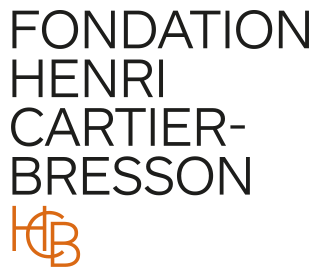
The Henri Cartier-Bresson Foundation, also known as Fondation HCB, is an art gallery and non-profit organisation in Paris that was established to preserve and show the work of Henri Cartier-Bresson and Martine Franck, and show the work of others. It was set up in 2003 by the photographer and painter Cartier-Bresson, his wife, also a photographer, Franck, and their daughter, Mélanie Cartier-Bresson.

Gold Rush, Shanghai, also known by other titles like Gold Rush. The Last Days of Kuomintang, Shanghai, is a black and white photograph taken by Henri Cartier-Bresson in 1948.
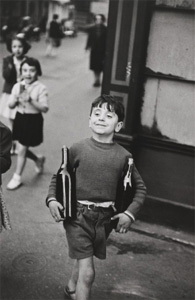
Rue Mouffetard, Paris, is a black and white photograph taken by Henri Cartier-Bresson in a Paris street in 1954.

Gestapo Informer Recognized by a Woman She Had Denounced, full title Gestapo Informer Recognized by a Woman She Had Denounced, Deportation Camp, Dessau, Germany, is a black and white photograph taken by Henri Cartier-Bresson in 1945. It is one of the most famous post-World War II pictures.

Alberto Giacometti à la Galerie Maeght, Paris, France, 1961, or, in English, Alberto Giacometti at the Galerie Maeght, Paris, France, 1961, is a black and white photograph by French photographer Henri Cartier-Bresson, taken in 1961. The picture depicts his old friend of two decades, the Swiss sculptor Alberto Giacometti, as he appears to be setting up his own exhibition at the Galerie Maeght, in Paris.

















